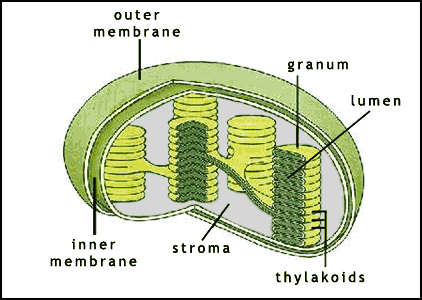The light reaction takes place in the chloroplast organelle of a plant cell, specifically in the thylakoids (the small disks as can be seen in the diagram at the right.) Photons (light rays) from the sun enter into the thylakoid specifically into special protein lodged in the membrane of the thylakoid called photosystem two (PHII). The energy from the photon ray excites an electron that is sitting at the bottom of PHII, and makes it shoot up to the top of PHII. Then the electron falls down a gradient to another special protein, also lodged in the membrane of the thylakoid, called photosystem one (PHI). As the electron falls down to the bottom of PHI, it releases some energy which is used to pump a Hydrogen ion across the thylakoid membrane from the stroma to the lumen. The electron then is excited by another photon ray which enters into PHI, and rises up to the top of PHI. The energy from the electron is used to phosphoralize an NADP plus molecule into an NADPH molecule. The NADPH molecule also takes in the electron, and then is transported to the Calvin Cycle where it will eventually be used to synthesize ATP. You may be wondering how the electrons in PHII and PHI are replaced, and that has a simple explanation. There are water molecules that the plant has obtained either through it's roots or from the air that are in the lumen of the thylakoid. PHII is a powerful enough protein that it can oxidize water into two Hydrogen ions (made up of one proton and one electron each), and one oxygen gas molecule. The oxygen gas is released as a by-product of photosynthesis, the Hydrogen ions stay in the lumen and add to the build up of Hydrogens in the lumen until they are pumped back through the ATP synthase, and the electrons enter PHII and then are excited by the photon rays.

The second half of photosynthesis, called the Calvin Cycle, which takes place in the stroma of the chloroplast, can be conducted without the presence of light, but it needs the ATP's and NADPH's that were produced in the light reaction to fuel it. Remember when i said that i had always thought photosynthesis was simply the way plants breathe? Well this is where that comes into play. Plants "breathe" carbon dioxide, and CO2 is one of the main inputs into the Calvin Cycle. The most important output of the Calvin Cycle is a 3-Carbon sugar, and in order to obtain a 3-Carbon sugar, 3 CO2 molecules must enter the Calvin Cycle at a time, so it is often explained in increments of 3 Carbon Dioxide molecules at a time. The carbon dioxide meets up with a huge complex protein called Rubisco, which latches onto the carbon dioxide molecule and brings it to the start of the Calvin Cycle. The Carbon Dioxide molecule merges with a RuBP molecule (Ribulose
Biphosphate), which is a 5-Carbon molecule. Together they make a 6-Carbon molecule, but it is a very unstable one, so it quickly breaks into two 3-Carbon molecules. 2 ATP's and 2 NADPH's are used per 3-Carbon molecule to fuel the rearrangement of the 3-Carbon molecules, until they are in the form of a pyruvate. One of the 3-Carbon molecules then drops a Carbon, and then the 2-Carbon molecule reconnects with the other 3-Carbon molecule and forms a 5-Carbon molecule. Another ATP comes and rearranges the 5-Carbon molecule into a molecule of RuBP, and then another Carbon Dioxide molecule enters, and the cycle starts all over again. For every three Carbon Dioxide molecules that enter the cycle, one 3-Carbon sugar is secreted. Glucose is the ultimate goal, so 6 Carbon Dioxides must cycle through in order to obtain one molecule of Glucose. The inputs of the light independent reaction include Carbon Dioxide, ATP, and NADPH, and the outputs include Glucose. This glucose then goes through cellular respiration in the mitochondria of the plant, and eventually ends up making tons of ATP. The entire Calvin Cycle, or light independent reaction, can be summed up in the diagram below.
That is the entire process of photosynthesis in all of the boring laborious details, but there are some cool aspects of photosynthesis too:
Did you know..?
Read more: Weird Facts About Photosynthesis | eHow.com http://www.ehow.com/facts_5412442_weird-photosynthesis.html#ixzz1AZ9nwAkF

